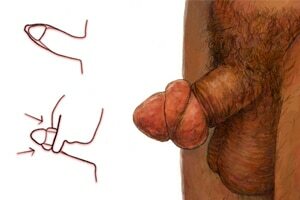Phimosis is the narrowing of male flesh to such an extent that it is impossible to expose the head of the penis. Typically, this pathology is found in about 9 out of 10 newborns, but by 3-4 years old it passes by itself. This phimosis is physiological. But there is also cicatricial phimosis, which develops due to insufficient elasticity of tissues. On the flesh, a scar tissue is formed, which prevents its stretching, so that the head outward becomes impossible. With urological examination, many small scars are found on the skin of the flesh. Almost all boys under the age of 3 observe phimosis processes, which are of physiological origin and self-eliminating by 3-4 years. If there is no independent elimination of the constriction, then the pathological phimosis is spoken about.

Causes of the occurrence of phimosis
It has already been said that physiologically caused phimosis develops due to adhesion of the flesh to the head. As for cicatricial phimosis, it is usually formed due to some pathologies, traumatization and other factors contributing to scarring of flesh tissues. There are many factors contributing to the development of the pathological process in sufficiently adult males. Common among them are:
- Inflammations of the genitals, genito-urinary infectious pathologies lead to a decrease in elasticity, resulting in tissue scarring;
- Primary syphilitic forms are usually accompanied by a lesion of the penis, healing wounds thus lead to the appearance of scars with the subsequent narrowing of the flesh;
- Sometimes the cause of extreme narrowing is an excessively short bridle provoking the occurrence of various injuries and infectious processes on the penis. As a result, scars are formed, consisting of scar tissue, which narrows the flesh, causing phimosis;
- If the flesh develops more slowly than the penis, during puberty this also leads to the appearance of phimosis, as a result of which the flesh constantly receives microtraumas leading to scarring;
- Traumatization of the penis like burns, mechanical damage is also fraught with the development of scar tissue with the subsequent formation of phimosis;
- Problems with metabolic processes, diabetes.
In addition to physiological and scarring, phimosis can be hypertrophic. A similar type of pathology is characteristic of persons with excess body weight. Redundancy of fatty tissues contributes to the growth of flesh. Because of this under the flesh accumulates an excessive amount of moisture, which is the starting factor for infectious processes and balanoposthitis. Externally, the flesh looks too long and big, which is not entirely aesthetically pleasing.
Stages of the disease
The presence of certain clinical manifestations of phimosis depends on the stage of the pathological process, but its main feature is the inability to withdraw the head from under the flesh during an erection. If the member is not erect, then it can be naked, with appropriate efforts. Such symptomatology is characterized by the initial stage of the pathological process.
 At the second stage of the disease, the flesh can not be moved from the head even when the penis is not excited. This stage is characterized by the appearance of inflammation, which is accompanied by a characteristic soreness. Of the member may appear specific seboration of purulent nature, inguinal lymph nodes increase, there is hyperthermia. With all the abundance of manifestations, a man is still capable of sexual intercourse, but he will not experience the most pleasant sensations.
At the second stage of the disease, the flesh can not be moved from the head even when the penis is not excited. This stage is characterized by the appearance of inflammation, which is accompanied by a characteristic soreness. Of the member may appear specific seboration of purulent nature, inguinal lymph nodes increase, there is hyperthermia. With all the abundance of manifestations, a man is still capable of sexual intercourse, but he will not experience the most pleasant sensations.
The third stage of phimosis development is characterized by the absolute impossibility of releasing the head. The tissues of the flesh have completely lost their ability to stretch. When trying to get the flesh out, the man experiences severe pain. There are urinary difficulties, manifested by the accumulation of urine in the preputial bag, followed by a drip out.
Complications and consequences of phimosis
Pathological narrowing of the flesh makes it difficult to observe intimate hygiene, which promotes constant infections and inflammations of the penis. At the same time, under the flesh, congestions of smegma are collected, which also provokes infectious and inflammatory processes. Another significant complication is the lack of a full sexual life, because when a man is excited, he experiences discomfort or even soreness in the penis. Even in the absence of such feelings, a man experiences psychological discomfort, considering himself flawed. Therefore, the treatment of phimosis is extremely important for the physical and psychological health of men and adolescents.
If you ignore the development of cicatricial phimosis, then later it will lead to problems with urination. In particularly advanced clinical cases, urinary processes are accompanied by urine penetration under the skin of the flesh, which leads to additional infection and inflammation leading to purulent processes.
If a patient avoids an appeal to a urologist at the initial stage of phimosis, motivating this fact by the fact that he does not have anything to worry about and does not hurt, then he risks "making money" stagnation. Such a complication is fraught with the emergence of many infectious pathologies of the genitourinary sphere, because this secret is ideal for the reproduction of pathogenic microorganisms. Since phimosis can lead to very disastrous consequences, it is better not to delay the approach to the urologist, but to timely solve the problem in a safer way.
 An even more dangerous consequence of phimosis is the pinching of the head, which results in the blueing of the penis, accompanied by painful symptoms. If you do not provide timely assistance, the man risks getting necrosis of the penis tissues with the subsequent amputation of the organ. No less dangerous is the fusion of the flesh with the surface of the head, which can occur at the 3 stages of development of the phimosis process. The flesh grows to the head through the synechiae - small fused patches that are prone to overgrowth, which is fraught with the complete fusion of the flesh with the head. If the patient, in the presence of such fusion attempts to move the flesh, then there will be acute pain and bleeding will open.
An even more dangerous consequence of phimosis is the pinching of the head, which results in the blueing of the penis, accompanied by painful symptoms. If you do not provide timely assistance, the man risks getting necrosis of the penis tissues with the subsequent amputation of the organ. No less dangerous is the fusion of the flesh with the surface of the head, which can occur at the 3 stages of development of the phimosis process. The flesh grows to the head through the synechiae - small fused patches that are prone to overgrowth, which is fraught with the complete fusion of the flesh with the head. If the patient, in the presence of such fusion attempts to move the flesh, then there will be acute pain and bleeding will open.
Therapeutic approach
Phimosis therapy is possible in two ways: medicamentous and operative. Medicamental therapy involves the use of antibiotic drugs and hormonal ointments. This approach to treatment is justified if the pathological processes are at the initial stages of development. Corticosteroid ointment preparations are used, the action of which is aimed at softening the scars. As a result, the tissues of the flesh become more elastic.
Ointment should be applied so that most of it falls into the prepuce bag. If the course of phimosis is complicated by inflammation, it shows the use of glucocorticoid ointment agents that help to remove edema and to heal microcracks.
Often in the initial stages of the phimosis process, stretching of the flesh is used. First it is steamed out by means of a 15-minute hot bath, then delicate stretching movements begin to perform. If such a procedure is accompanied by uncomfortable sensations, then they end.
Varieties of surgical treatment of
A classical treatment for cicatricial phimosis is surgery. Circumcision or excision of the flesh is recommended when other techniques no longer provide the desired effect. This tactic of treatment is highly effective, although there are some drawbacks, such as a long recovery period, the formation of postoperative swelling, and bleeding.
Due to such complications, laser therapy has been increasingly used to remove cicatricial phimosis. This method is especially effective in cases when the use of ointment and stretching is useless. In addition, a similar treatment for phimosis has several advantages over circumcision:
- The procedure is safe in terms of bleeding;
- Laser operation is absolutely painless;
- There is no characteristic postoperative swelling of the tissues;
- The recovery period lasts much less;
- There is no chance of complications and any adverse reactions.
If the pathology has reached 3-4 degrees and complicated by paraphimosis or acute form of balanoposthitis, then surgery is shown, in which the flesh is dissected along the penis. When paraphimosis circumcision is contraindicated in connection with circulatory disorders of the blood flow, and in the presence of concomitant acute balanoposthitis, it is strictly forbidden to circumcise, because postoperative sutures can become untenable. After the dissection of the flesh, it is necessary to wait some time until the blood supply is restored and inflammation passes. Only then can the patient be circumcised.
Statistics show that in most men, phimosis is hereditary and genetic, so no specific preventive measures have been developed. With regard to secondary prevention, it implies compliance with the rules of intimate hygiene. In addition, during the water procedures thoroughly wash the head, as much as possible moving the flesh. If there is a slightest suspicion of the presence of phimosis processes, visit a specialist immediately.



